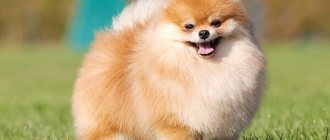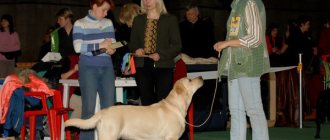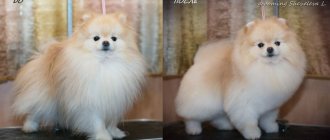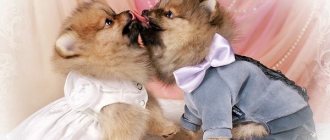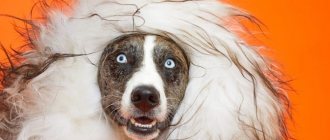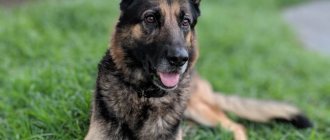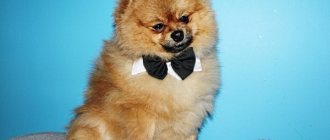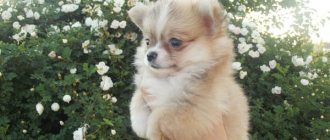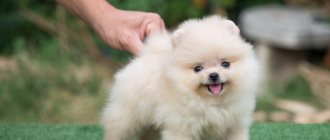What should you take with you?
For the exhibition you will need:
- collar and leash;
- overalls (if the event takes place in the cold season);
- ringovka - a leash for showing (a thin smooth cord without metal parts is suitable for a Spitz);
- transportation cage;
- litter;
- treats, food, clean water;
- napkins, bags that will come in handy if your Pomeranian goes to the toilet;
- wool brush and comb;
- medications, including sedatives;
- pin for attaching the exhibition number;
- documents (copy of pedigree, veterinary passport, certificates from a doctor and about previous injuries, as well as an invitation and payment receipt).
How to choose a leash for a Spitz
The leash is selected after the puppy is accustomed to walking and following commands. Since Spitz dogs, depending on the variety, reach half a meter in height, leashes for them vary according to weight. It’s easy to choose the strength of an accessory – the maximum permissible weight is indicated on the product.
Miniature Pomeranian Spitz on a leash
The leash for the Pomeranian should be thin and light, but for the Wolfspitz (Keeshond), the largest Spitz, reaching a weight of 20 kg, it should be much stronger. It can be leather, canvas, nylon, nylon, but with a convenient tension carabiner. The length depends on the distance you plan to release the dog:
- if it is necessary to lead the pet from the home to the place of walking, a leash of any length is selected, preferably the minimum;
- for long walks on a leash, the length for a puppy should be 3 meters, for an adult - 5 meters, this is what guarantees the free movement of the pet, carried out under the control of the owner.
Attention! The leash must be unfastened while training on the apparatus, otherwise the dog may become entangled in it and get injured.
A good alternative for a leash is a tape measure. It allows you to easily adjust the length. There are cable tape measures and safer tape ones.
Preparing a Spitz for an exhibition
Before showing, the following procedures must be carried out:
- The washing up. In order for the undercoat to dry completely, the Spitz needs to be bathed 2-3 days before the exhibition. You can use regular detergent or dry shampoo, as well as an oil-free conditioner (so as not to weigh down the coat). After your bath, use a hairdryer.
- Combing. A hard natural brush will come in handy, which is used to comb the fur immediately before the show. Grab small strands: this will increase the duration of the procedure, but will make the dog’s fur coat lush.
- Grooming. The coat is lightly trimmed on the ears and in the ears, between the toes and around the paws. Strands that are different in color and look bad should be completely removed.
- Nail trimming. After trimming, you need to use a nail file to shape the claws.
- Tartar removal. For this purpose, special elixirs and dental instruments are used. You can carry out the procedure yourself, but at least for the first time it is advisable to invite a veterinarian.
- Ear cleaning. They are wiped with napkins or cotton swabs. If symptoms of the disease occur, it is advisable to use drops prescribed by the doctor.
Pomeranian Spitz examination
Look at the four “Pomeranians” presented here (A, B, C, D) and formulate your own opinion about the correct type and appearance of each of them. Then make a preliminary placement of dogs in 1st, 2nd, 3rd and 4th places. If you are not familiar with the Pomeranian standard, please read the "Brief Description of Exterior" section before placing. Of course, a dog with a lush coat always needs a “manual” inspection, but a visual inspection will help determine some of the advantages and disadvantages of the exterior and allow you to make a preliminary arrangement.
Movements. Before the individual examination begins, he will look at all four dogs in motion to make sure that none of them is limping, and also to complement his first impression of the exterior. Looking at the movements in profile, you will see that three out of four Pomeranians do not have such elastic pasterns as I have depicted in the picture. Flexibility in movement is one of the most important points to pay attention to. The requirements for pastern flexibility are different for each breed, but they are most often forgotten when examining Pomeranians. This negligence is one of the reasons why a large number of Pomeranians with defective, straight shoulders appear in the rings.
A complete or almost complete lack of elasticity in the pasterns of a Pomeranian is a sure sign that under his coat you will find straight and sometimes short shoulders. For the Fox Terrier and Lakeland Terrier, very slight flexibility of the pastern in movement is normal, but, unlike the Pomeranian, they are characterized by a specific “terrier” front.
When the load during movement is transferred from the front limb (in the figure - from the front left limb), it should be bent at the metacarpal joint and carried back at an angle of 45°. If this does not happen, then most likely a “manual” examination will confirm that the dog has a straight shoulder.
Short description. The Pomeranian is a compact, square dog. The skull is flat and large in relation to the “fox”, wedge-shaped muzzle. The teeth are straight, complete; scissor bite. The nose is black or matches the base color. The ears are small and erect. The eyes are dark, medium in size, somewhat oval in shape, and have an intelligent expression. White, orange, dark sable and cream have a black edging around the eyes.
The rather short neck blends harmoniously with the sloping shoulder blades. Holds his head high. The back and loin are short, the ribs are well arched, and the chest is quite deep.
I believe that the shoulders should be sloping, the front of the chest should protrude somewhat. The forearms are straight and I think their length should be equal to the depth of the body. The skeleton is not heavy. In my opinion, the pasterns should be slightly sloping, which creates a static balance to the dog's front. The angles of the hind limbs (knee and hock joints) are moderately pronounced. The stomach is moderately tucked.
The abundantly dressed, high-set tail is thrown over the back and lies straight and even on it. The paws are compact, “cat-like”.
The orange is characterized by a “double” coat: a soft undercoat and a rather long, completely straight, hard guard hair. The whole body is well dressed. The very lush coat around the neck, on the front of the shoulders and chest forms a frill. The front is decorated with long wool. The hindquarters are well dressed up to the hocks.
Any colors are acceptable, but no white or black markings. White chests, paws or limbs in non-white dogs are considered a serious fault.
My example, which most closely matches the standard, has shortcomings that are not, however, related to structural shortcomings. Although the other three dogs have a number of advantages, attention will be paid to their shortcomings. If any structural detail hidden under the lush fur is not mentioned, this means that palpation has shown its correctness.
Dog A. The first impression can be deceiving: the lush coat hides the forelimbs exposed in front of the body, which is due to the straight shoulder blade and short, straight shoulders. In this position, static balance is achieved to some extent by vertical pasterns.
The fur hides the elbows set back from the irregular, flat sides. The front part of the chest does not protrude, forming a depression between the forelimbs. Large, round eyes, a short “rabbit” muzzle and a rounded skull do not meet the standard.
Dog B. Its correct structure of coarse, “double” coat lacks fullness on the front of the shoulders, chest, hips, shins and rump. The impression is spoiled by the correctly planted tail, which is tucked back and to the side, which is a drawback. Abundant hair and a tail carried straight over the back are desirable breed characteristics.
Will you forgive these two shortcomings, noting such advantages of the dog as a pedigree head, compact body, good angles of the front and rear limbs?
Dog C. This dog has overly large ears and an irregularly convex forehead. The muzzle is of sufficient length, but seems heavy due to the rather large upper lip. Excessively large eyes are too wide apart. The dog has a heavy bone structure, forelimbs with soft pasterns, and cow-like hindlimbs. It is felt that under the fur there is an overly wide chest and twisted elbows.
Dog D. This dog looks tall-legged. However, the body is raised above the level of the elbows due to the straight set of the shoulder blades and shoulders, and not due to the long limbs. Due to the straightened angles of the hip joints, her tail is set close. The muzzle is too short, the skull is too convex at the front and too rounded at the top. There is no black edging around the eyes, which is a disadvantage for white, orange and dark sable Pomeranians. According to the standard, brown nose and edging around the eyes are allowed in sable-colored dogs with chocolate hair tips.
Arrangement. I put dog B in first place, dog A in second, dog D in third, and dog C in fourth. The choice between examples A and B in favor of dog B was made due to the correctness of its addition. What if both dogs were built correctly?
In this case, the lushness of the coat would be taken into account, you would have to choose from two heads of different types, paying special attention to the muzzle and the shape of the eyes. Personally, I have no doubt: Dog B has a fox-shaped or “foxy” head, and Dog A does not.
Translation from English by Galina Soroka, Friend magazine (dogs), 1994-1
Dog training
Even if a Spitz looks perfect, but behaves nervously and does not follow the simplest commands, it is unlikely to achieve success.
You need to start training with your pet at an early age, devoting 5-10 minutes a day to training. You should master commands, stances, and get used to inspection on the table and in the ring. It is also worth accustoming your dog to the touch of strangers and examination of teeth so that the pet does not show aggression at the exhibition.
The main thing when training is patience and love for your pet.
Be sure to stock up on treats to encourage him and under no circumstances make him nervous. tagsexhibition tartar food paw injury
Dog show stand - what is it for?
The main goal of visiting an exhibition is to get an expert description and assessment of the dog. The expert must carefully examine the dog, analyze its breed qualities and describe how accurately they correspond to the existing breed standard. For this purpose, the dog is always assessed in movement and in standing position.
We'll talk about movement in the ring next time, but now let's focus on the dog's exhibition stance. A show dog must be able to stand still and calm. While the dog is standing, the expert will look at it from the side and also touch it - he will evaluate the dog’s condition, the condition of the coat, the strength of the limbs, etc.
Chucky Black Belogorye at the international dog show in Poland (Sieradz).
July 2021. The examination is conducted by Jane Paradise (Great Britain). All dogs, without exception, must demonstrate the number of their teeth and their appearance, the condition of their gums and bite upon the command “Teeth”. Here, at the expert’s discretion, there are two options for the development of events - the expert can raise the dog’s lips independently or ask the handler to do it.
International Dog Show in Minsk (Belarus) - June 2016. Natalia Levitte (Germany) examines Chuckie Black's teeth.
The expert also mandatory manually assesses the condition of the testes in male dogs. The dog must be prepared for all possible manipulations of the expert and react to them completely calmly.
Keep in mind that during the examination of the dog, the expert evaluates not only the physiological, but also the psychological characteristics of the dog. Dogs that demonstrate cowardice or aggression in the ring will be disqualified and will not receive a breeding assessment. This means that in the future they will not be allowed to breed!



